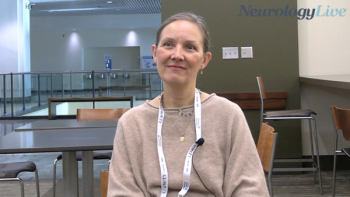
CMSC Poster Gives Demographic Insights for Phase 3 PERSEUS Study of Tolebrutinib
Key Takeaways
- The PERSEUS trial investigates tolebrutinib's efficacy in PPMS, enrolling 767 patients with a mean EDSS of 4.9.
- Tolebrutinib is engineered for brain protection, selectively targeting BTK to minimize off-target effects and improve safety.
The ongoing PERSEUS trial explores tolebrutinib's potential as a treatment for primary progressive multiple sclerosis, with results anticipated soon.
The phase 3 PERSEUS trial, an ongoing, double-blind, placebo-controlled study (NCT04458051) testing the therapeutic potential of tolebrutinib (Sanofi), an investigational Bruton tyrosine kinase (BTK) inhibitor, as a new treatment for patients with primary progressive multiple sclerosis (PPMS). At the
PERSEUS, a parallel-group, multicenter, event-driven trial, enrolled 767 patients with PPMS, with most patients male (54%) and White (83%). At baseline, the mean Expanded Disability Status Scale (EDSS) was 4.9 (median, 5.0; n = 766), which was well within the inclusion criteria of 2.0 to 6.5 at screening. Led by
Results for PERSEUS, which tests efficacy, safety, and tolerability of tolebrutinib, are expected to come later this year. In the study, patients are randomly assigned 2:1 to either tolebrutinib at 60 mg doses or placebo, with delay in disability progression as the primary end point. At baseline, most participants (59%) were treatment-naïve, and almost all the cohort (89%) had no gadolinium-enhancing lesions. Overall, the median T2 lesion volume was 10.8 cm3.
As an investigational BTK inhibitor, tolebrutinib is engineered for enhanced brain protection, enabling it to modulate immune activity both peripherally and centrally. Like ibrutinib, tolebrutinib is an irreversible covalent inhibitor of BTK, leading to a prolonged suppression of BTK signaling even after plasma levels decline. The agent is designed to minimize off-target effects by selectively targeting BTK with fewer interactions with other kinases, which may improve safety and tolerability.
PERSEUS is one of many studies in tolebrutinib’s clinical program. Some of the others include the phase 3 HERCULES study in non-relapsing secondary progressive MS (nrSPMS), and the GEMINI studies (GEMINI 1 [NCT04410978] and GEMINI 2 [NCT04410991]), 2 phase 3 trials in relapsing MS. In March,
Tolebrutinib’s submission was based on data from HERCULES, a double-blind, randomized study of 1131 patients with nrSPMS who were followed for a 48-week treatment period. Results from the study showed that treatment with the BTK inhibitor resulted in delayed time to onset of 6-month confirmed disability progression (CDP), the primary end point, by 31% compared with placebo (HR, 0.69; 95% CI, 0.55-0.88; P = .0026). On secondary end point, the number of patients who experienced confirmed disability improvement increased by nearly 2-fold, 10%, for those treated with tolebrutinib compared with 5% of those in the placebo group (HR, 1.88; 95% CI, 1.10-3.21; P = .021).3
More recently, a post-hoc analysis of the trial revealed that tolebrutinib is more effective in patients who have a higher number of paramagnetic rim lesions (PRLs). In HERCULES, HERCULES, treatment with the therapy led to a 54% reduced risk in 6-month CDW among patients with at least 4 baseline PRLs, the highest quartile group observed. In GEMINI, a similar risk mitigation was observed, with a 46% and 49% risk reduction in participants with 1-3 and at least 4 PRLs, respectively. Of note, this data was not connected to this FDA filing submission/acceptance for tolebrutinib.4
REFERENCES
1. Fox RJ, Reich DS, Traboulsee A, et al. (DMT37) Baseline Characteristics in the Tolebrutinib Phase 3 Primary Progressive Multiple Sclerosis PERSEUS Clinical Trial. Presented at: 2025 CMSC Annual Meeting; May 28-31. Phoenix, AZ. Abstract DMT37
2. Press Release: Tolebrutinib regulatory submission accepted for priority review in the US for patients with multiple sclerosis. News release. Sanofi. March 25, 2025. Accessed May 27, 2025. https://www.globenewswire.com/news-release/2025/03/25/3048411/0/en/Press-Release-Tolebrutinib-regulatory-submission-accepted-for-priority-review-in-the-US-for-patients-with-multiple-sclerosis.html
3. Fox RJ, Bar-Or A, Traboulsee A, et al. Efficacy and Safety of Tolebrutinib Versus Placebo in Non-Relapsing Secondary Progressive Multiple Sclerosis: Results from the Phase 3 HERCULES Trial. Presented at: 2024 ECTRIMS; September 18-20; Copenhagen, Denmark. Abstract 4027.
4. Oh J, Fox RJ, Arnold DL, et al. LB1.1. Paramagnetic Rim Lesions as a Prognostic and Predictive Biomarker in the Tolebrutinib Phase 3 Trials for Disability Outcomes. Presented at: 2025 ACTRIMS Forum; February 27-March 1; West Palm Beach, FL. ABSTRACT LB1.1
Newsletter
Keep your finger on the pulse of neurology—subscribe to NeurologyLive for expert interviews, new data, and breakthrough treatment updates.



































